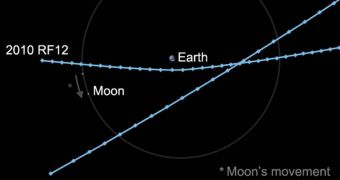Experts at a NASA lab announce that two asteroids will pass close to our planet today, September 8. The two space rocks are in unrelated orbits, the team says, and pose no danger to Earth.
Each of the celestial bodies is a few meters in diameter, and wouldn't have caused any major damage if they were to strike anyway. What's interesting is that they will both move past the planet the same day, even if they come from very different orbits.
The attached graphic reveals the paths that the two asteroids will take as they swing past Earth. When they are nearest, they should become visible to amateur astronomers with moderate-sized telescopes.
Objects of this class, 10-meter-sized near-Earth asteroids, have a very small chance of hitting the planet overall, but a high chance of passing within lunar distance.
In fact, this happens once per day on average. Such a boulder slams into the atmosphere and burns up about once every 10 years.
Astronomers estimate that the undiscovered population of NEO orbiting the solar system in our vicinity could number as much as 50 million members.
The two new objects were discovered on Sunday, September 5, by the Tucson, Arizona-based Catalina Sky Survey, experts at the NASA Jet Propulsion Laboratory (JPL) announce.
“Near-Earth asteroid 2010 RX30 is estimated to be 32 to 65 feet (10 to 20 meters) in size and will pass within 0.6 lunar distances of Earth (about 154,000 miles, or 248,000 kilometers) at 2:51 am PDT (5:51 a.m. EDT) Wednesday,” the team explains.
“The second object, 2010 RF12, estimated to be 20 to 46 feet (6 to 14 meters) in size, will pass within 0.2 lunar distances (about 49,088 miles or 79,000 kilometers) a few hours later at 2:12 pm PDT (5:12 pm EDT),” they add.
Keeping an eye on NEO is extremely important, given the large number of unknown space rocks that lurk in outer space. On top of that, our solar system features two asteroid belts.
Dangerous objects may exist in both of them, and more telescopes should be built to try and detect, identify and analyze them.
NASA's Spitzer and WISE have already been conducting such research for some time, but the sheer volume of work to be done is massive.

 14 DAY TRIAL //
14 DAY TRIAL //